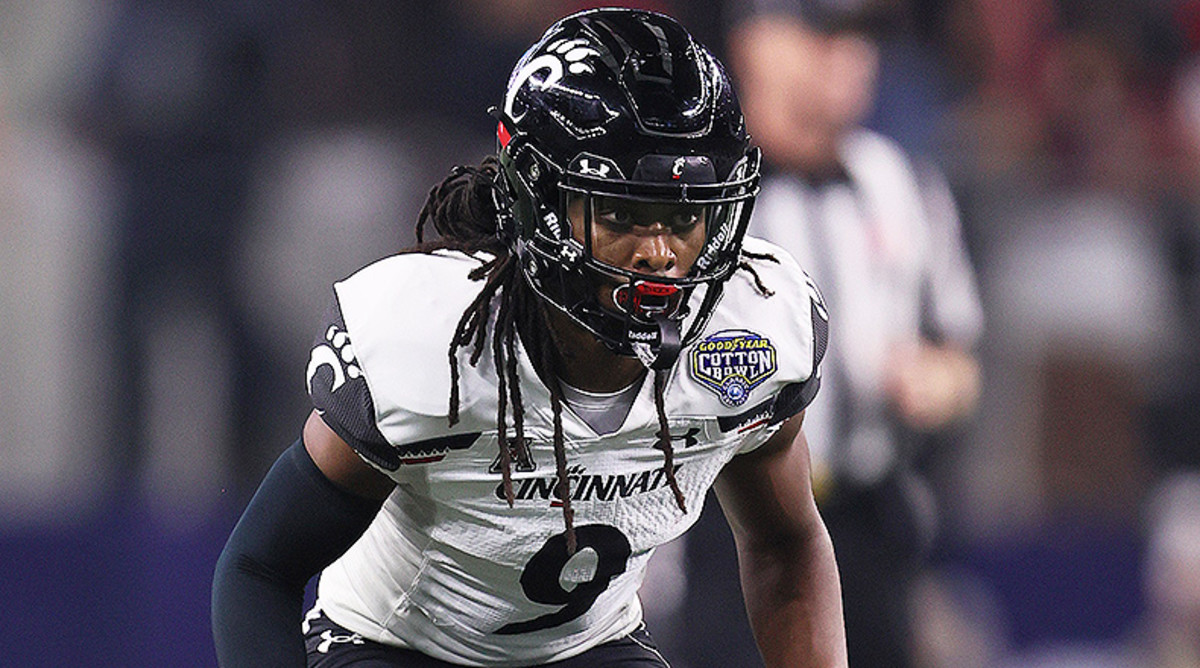Razorback football is back for the most anticipated season in several years. The Hogs return several key players from an Outback Bowl win and now hoping to keep building on that success.
In their way is Cincinnati, a playoff team a year ago. The Bearcats have become a monster under Luke Fickell, going 44-7 (27-3 AAC) over their last four seasons, with three straight American Conference title game appearances.
Meet the Bearcats
Confused by any of the advanced stats you see here? Be sure to check out the glossary.
Luke Fickell had Cincinnati on a trajectory towards its 2021 season. Now comes the question: what’s next? How do you follow up the best season in school history, one that non-power schools can only dream of?
RELATED: Roman dictators, weird spaghetti sauce, Longfellow poems, and a football program that’s finally discovering its true potential. Let’s meet the Cincinnati Bearcats.
Cincinnati is due for a step back, but don’t be surprised if it’s a small one. The Bearcats showed great depth last year, and they were not completely gutted by graduation and the NFL. Yes, key players are gone, but a lot of snaps return on both sides of the ball.

We’re using 2021 stats for all these graphics because, obviously, that is all we have at this point. We’ll phase in the use of new stats over the next couple of weeks.
The Bearcats were a bonafide top-10 team in 2021. Despite a poor strength of schedule (95th), they compiled a resume worthy of inclusion in the College Football Playoff.
Scouting Report
Cincinnati is searching for a starter at QB and RB, but their offensive line and receiving rooms appear to be in great shape. Bearcat receivers are tall, physical, and experienced. The Bearcats’ patience and efficiency on offense could present some problems for a Razorbacks’ defense that isn’t very disruptive.
Cincinnati’s defense returns just four starters. They seem to have depth, but topline talent is a potential concern, especially in Week 1. The Bearcats are elite in the red zone and force a lot of turnovers, but are vulnerable to the kind of ground-and-pound attack that Arkansas is bringing.
Three Names to Know
- Deshawn Pace. The Cincinnati “sniper” is their most productive returning defender. He led the Bearcats in interceptions (4) and was fourth in tackles (96) in 2021. Knowing what he’s going to do at all times will dictate how Arkansas attacks.
- Ben Bryant. The likely starting quarterback has the challenge of replacing Desmond Ridder. He threw for more than 3,000 yards at Eastern Michigan last season. He’s much less mobile than Ridder, but as a pure passer, he’s very good.
- Nick Mardner. The Hawai’i transfer had almost 1,000 receiving yards last year. He’s 6’6 and a matchup nightmare for cornerbacks. Cincinnati has to replace their leading receiver, so we’ll see if he’s up to the task.
When the Bearcats have the ball
Cincinnati has a new offensive coordinator, as former OC Mike Denbrock was hired by Brian Kelly at LSU. The Bearcats simply elevated passing game coordinator Gino Guidugli. It is unlikely that their basic scheme will change much despite the change in leadership.

With a veteran quarterback and a veteran running back, Cincinnati was as deliberate and efficient (9th in Success Rate) as you might expect. More than half their drives managed at least one snap inside the opponent 40 (25th) and they were excellent at finishing those drives with points (20th).

Fickell’s offenses at Cincinnati have been modern but fairly conservative. The Bearcats like to stay in standard downs as often as possible. In 2021, they had the 4th-best Leverage Rate in the country (percentage of plays in standard downs). Remember that “passing downs” are 2nd and 10+, 3rd and 5+, 4th and 5+, and most plays under two minutes when tied or trailing by one possession. All other plays are standard downs.
Good offenses are often very good at staying in standard downs, and Cincinnati was no exception last year. They ranked 7th in the country at Standard Downs Success Rate and 4th in Leverage Rate, meaning simply that they were very good at staying on schedule. Their conservative nature meant that they were naturally worse on passing downs (89th in PD EPA+), where their lack of explosiveness (114th) came out of a desire to just keep the sticks moving.

Cincinnati’s run game was extremely good and quite underrated, ranking as one of the most efficient in the country.
The offensive line — which returns four starters from last year — is easily the strength of the offense. This will be a major concern for an Arkansas defensive line that’s trying to replace John Ridgeway in the middle.
Schematically, the Bearcats are very multiple, although they typically use one running back. You’ll see 4-wide, 3-wide, and even 2-wide and 2-tight. There are a ton of NFL concepts in this offense. They are also heavy on RPOs on early downs, like this one:
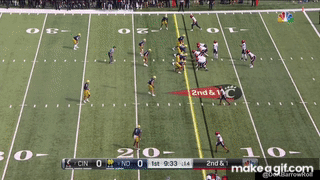
This is a very safe 2nd-and-1 playcall that simply keeps the chains moving. Cincinnati has no problem being patient and taking whatever the defense gives them.
Desmond Ridder’s main talent as a quarterback was his intelligence and decision-making. Here, he recognizes the cornerback bailing out as Cover 3 and immediately attacks the open seam with a good throw:
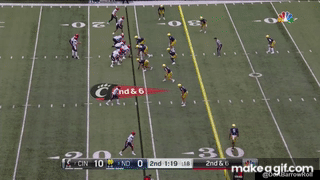
Ridder was not overwhelmingly talented as a passer, but he consistently made the right decisions with the ball in his hand. Cincinnati will use a lot of quick passes and rhythm throws. For longer dropbacks, Ridder had a little bit of scramble ability, which he occasionally put to good use.
But Ridder is gone, and the Bearcats are instead deciding on a new quarterback.
Personnel
Quarterback
- Ben Bryant, 6’3, 220, Senior; 3,121 pass yards, +60 EPA at Eastern Michigan
- Evan Prater, 6’4, 200, Sophomore
Bryant was the backup that Cincinnati essentially sent down the minor leagues. After three seasons at Cincinnati, he transferred to Eastern Michigan last season, where he was fantastic in leading the Eagles to a bowl appearance. Now he’s been “called up” to vie for the starting job with Evan Prater, a former 4-star recruit.
There are pros and cons to each. Bryant is more experienced and more polished in the pocket, but Prater has more all-around athleticism. The Bearcats closed their fall camp without naming a starter.
Running Back
- Chuck McClelland, 5’11, 200, Senior; 190 rush yards, +4 EPA, +0.13 EPA/Rush
- Ryan Montgomery, 5’11, 200, Senior; 312 rush yards, +10 EPA, +0.25 EPA/Rush
All-American tailback Jerome Ford (1,319 rush yards, +38 EPA, +0.16 EPA/Rush) is off to the NFL, so the two backups from last year are vying for the starting job. McClelland — who tore his ACL in 2019 and 2020 — seemed to have an advantage during fall camp, but the Bearcats ended their fall camp without declaring him the starter. Montgomery’s stats were better last year, and he’s also the team’s primary punt returner.
Receivers
- Nick Mardner, 6’6, 215, Senior; 913 receiving yards, +34 EPA at Hawai’i
- Tyler Scott, 5’11, 185, Junior; 520 receiving yards, +20 EPA
- Tre Tucker, 5’9, 185, Senior; 426 receiving yards, +15 EPA
Tight Ends
- Josh Whyle, 6’6, 250, Senior; 332 receiving yards, +15 EPA
- Leonard Taylor, 6’5, 255, Senior; 268 receiving yards, -1 EPA
Star receiver Alec Pierce (884 receiving yards, +47 EPA) is off to the NFL, but the Bearcats return their second- and third-leading receivers, plus both tight ends. They also managed to snag Hawai’i’s leading receiver Nick Mardner, one of the more productive receivers available in the portal during the offseason.
So it’s fair to say that whoever Cincinnati starts at quarterback will have options for throwing the football. The size of Mardner plus the tight ends is obviously going create some concerns for Arkansas’ defense.
When the Hogs have the ball

Like Arkansas, Cincinnati had a bend-don’t-break element to the defense. They were merely decent at preventing successful plays (16th in Success Rate) and stopping drives from getting inside their 40 (29th), but the Bearcats didn’t give up big plays (4th in Explosiveness) and were good at preventing opponents from getting points on promising drives (6th in Points Allowed per Scoring Chance).

Cincinnati’s strengths and weaknesses are very apparent from this chart: if the Bearcats get you in a passing situation, like a third-and-long, you’re as good as done (6th in Passing Downs EPA+, 7th in Passing Downs Success Rate). But they were merely average and keeping opponents from grinding out long drives against them (20th in Leverage Rate, 51st in Standard Downs Success Rate).
The Hogs were similar to Cincinnati on offense: on standard downs, they were fantastic, especially when throwing the ball (2nd in SD Passing EPA+). But on passing downs, the Hogs struggled, which makes either staying on schedule or hitting huge plays of high importance.
Opponents tended to run the ball a ton against Cincinnati: 63% of standard downs snaps against the Bearcat defense were runs, and 37% of passing downs snaps. The FBS averages were 59% and 33%, respectively.
This was most evident in the playoff, when Alabama was able to neutralize the Bearcats’ defensive speed. In this first play, Cincinnati is using an over front (slanting the defensive line towards the strong side), and counting on quick reactions from its linebackers and safeties in case of a run into the boundary. The Tide run into the boundary and have no issues blocking the Bearcat defenders:
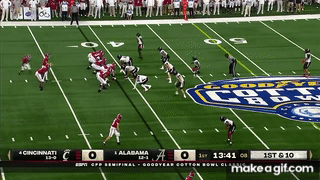
Remember two things you see here: that the run is into the boundary, and that Jameson Williams is in motion to the open side of the field. Both will be relevant later.
Later in the drive, Cincinnati again fails to put enough defenders into the box and again is unable to get around the blocks thrown by the Tide:
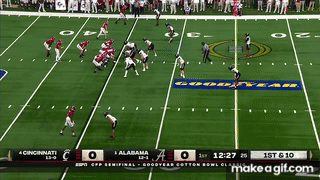
As you can probably tell from watching the above clips, Cincinnati’s base defense is a 3-3-5. The 3-3-5 is a unique defense that is used most often by schools that cannot recruit enough big defensive linemen or linebackers to run a 4-3 or 3-4. It’s become even more popular in the age of spread offenses. Its aggression is its biggest strength and biggest weakness. A 3-3-5 cannot reliably create negative plays without blitzing, but blitzing opens the door for big plays by the offense.
Cincinnati’s 3-3-5 is relatively conservative, allowing the Bearcats to showcase a talented and well-coached secondary. As we’ve already seen, Cincinnati is elite at preventing big plays (1st in the nation in Standard Downs Explosiveness last year), good at tightening up in the red zone, and good at forcing turnovers (3rd in the FBS in total forced turnovers).
But they are not without weaknesses.

Cincinnati’s pass defense was insanely good in 2021. In addition to preventing big plays or even good plays, the Bearcats got their fair share of interceptions and sacks.
Take a closer look at the run defense stats I’ve circled in red. These follow a similar pattern to what we saw in our preseason preview of the Razorback offense: they get better as you move down the list of stats. These five stats are in a specific order. The two at the very top are primarily the responsibility of the offensive line (or defensive line, since we’re looking at defense here). But as you move down, each stat has less responsibility from the line and more for the running backs (or linebackers and safeties, for defense). The final stat — Bonus Yards per Opportunity — has basically nothing to do with the line and everything to do with the running backs or back end defenders.
Here are the definitions of each stat:
- Short Yardage Success %: percentage of run plays on 3rd/4th down and 1 that converted the first down, this is 100% on the line
- Stuffed %: percentage of run plays where the back is tackled for no gain or a loss, this is 100% on the line
- Line Yards per Rush: an adjusted yards-per-carry metric that assigns the first six yards of any run play, this is about 90% on the offensive line
- Opportunity %: percentage of run plays that gain 6+ yards, this is about 50-50 between the blockers and the runner
- Bonus Yards per Opportunity: yards per carry beyond six on any opportunity run, this is 100% on the running back
As I wrote in the offense preview:
Arkansas’ ranking for these four stats (note: I didn’t include short yardage success) in order were 77th > 69th > 58th > 47th. That they got increasingly better as more running back responsibility was added in suggests that Arkansas’ running backs were much better than their run blocking.
You can see that Cincinnati’s defense follows an identical pattern. The more the stat is related to the defensive line, the worse it was for the Bearcats. The final stat — preventing big runs, basically, which is the responsibility of the back end — was their best.
Some of this is scheme-related, as Cincinnati’s 3-3-5 aims to be strong against the pass and prevent big plays, in exchange for allowing some efficient rushing. But another part of it is that Cincinnati simply has a harder time recruiting the elite, disruptive defensive linemen that you see all over SEC rosters. Their scheme does a nice job of minimizing this, but the weakness is still there.
Personnel
Defensive Line
- Jabari Taylor, 6’1, 280, Senior: 29 tackles, 2 sacks
- Jowon Briggs, 6’1, 313, Senior; 42 tackles, 3 sacks
- Malik Vann, 6’4, 275, Senior; 33 tackles, 2 sacks
All three of these guys were rotation players a year ago, but only Vann was a true starter. The Bearcats have lost their starting nose tackle and weakside defensive end. Depth and experience aren’t concerns, but unless someone steps up, topline talent might be.
Linebackers
- Deshawn Pace, 6’2, 215, Junior; 95 tackles, 4 interceptions
- Wilson Huber, 6’4, 250, Senior; 15 tackles
- Jaheim Thomas, 6’4, 245, Sophomore; 23 tackles
The linebacking corps is in worse shape, as the Bearcats are losing their two leading tacklers. Pace, the lone returning (part-time) starter, played a hybrid linebacker-safety role known in Cincinnati as the “sniper” position. The sniper always lines up to the field (open) side, and often plays a different coverage from the rest of his teammates, with the goal of creating offensive confusion.
The sniper has significant freedom to react quickly to wherever the ball goes:
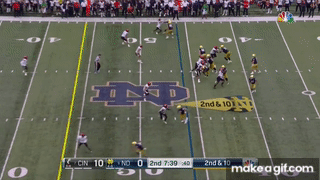
Both Alabama and Notre Dame ran into the boundary frequently (as in the above Alabama gif), largely in order to avoid the sniper and instead test Cincinnati’s defensive line on the edge.
Alabama also used a ton of motion to the field in order to force the sniper to declare his intentions. On this RPO, Pace is standing at the 45-yard line and does not pursue the motion receiver, which tells Bryce Young he should hand the ball off instead of throwing the slant to Jameson Williams:
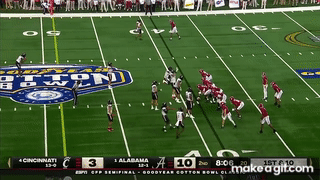
Cornerbacks & Nickel
- Arquon Bush, 6’0, 198, Senior; 40 tackles, 3 interceptions
- Ja’quan Sheppard, 6’2, 200, Senior; 3 tackles
- Sammy Anderson Jr., 6’0, 190, Sophomore; 1 tackle
Safeties
- Ja’von Hicks, 6’2, 200, Senior; 56 tackles, 2 interceptions
- Bryon Threats, 5’10, 200, Sophomore; 8 tackles
The largest loss on Cincinnati’s defense is Sauce Gardner, the all-American cornerback who allowed zero touchdowns in his entire career. Bush and Hicks are the returning starters here; Sheppard and Anderson have barely played during their time at Cincinnati.
Keys to the Game
Don’t get cute. This one will probably work best as an ugly win. The Hogs want to grind this out behind their offensive line. Cincinnati’s defense will let you grind out successful plays for a while, but they don’t give you any big ones, and then they tighten up when you cross midfield (and even moreso if you reach the red zone). Playcalling has to be very crisp in the scoring zone. Settling for too many field goals or repeatedly bogging down around the 40 will cost you the game. Key Stat #1: Points per Scoring Opportunity
Win or draw the turnover battle. Notre Dame turned the ball over three times in the game’s first 18 minutes, fell behind 17-0, and couldn’t mount a comeback. With Cincinnati still figuring things out on both sides of the ball, the Hogs are in good shape if they don’t give any free gifts. The Bearcats sidestepped some of their issues on the defensive front by ranking 3rd in the nation in forcing turnovers last year. It’s critical that they go +1 or better in turnovers. Key Stat #2: Turnover Margin
Unleverage the Bearcat offense. The Bearcat offense wasn’t very comfortable in passing downs last season, and that was with a veteran quarterback. Cincinnati’s offense is predicated on staying on schedule, so the Hogs need to find a way to knock them off schedule. Run stuffs, sacks, and incomplete passes are the best ways to accomplish this. Key Stat #3: Leverage Rate
The latest from Fayette Villains, straight to your inbox
Enter your email to subscribe and receive new post alerts and other updates. You can unsubscribe at any time.
